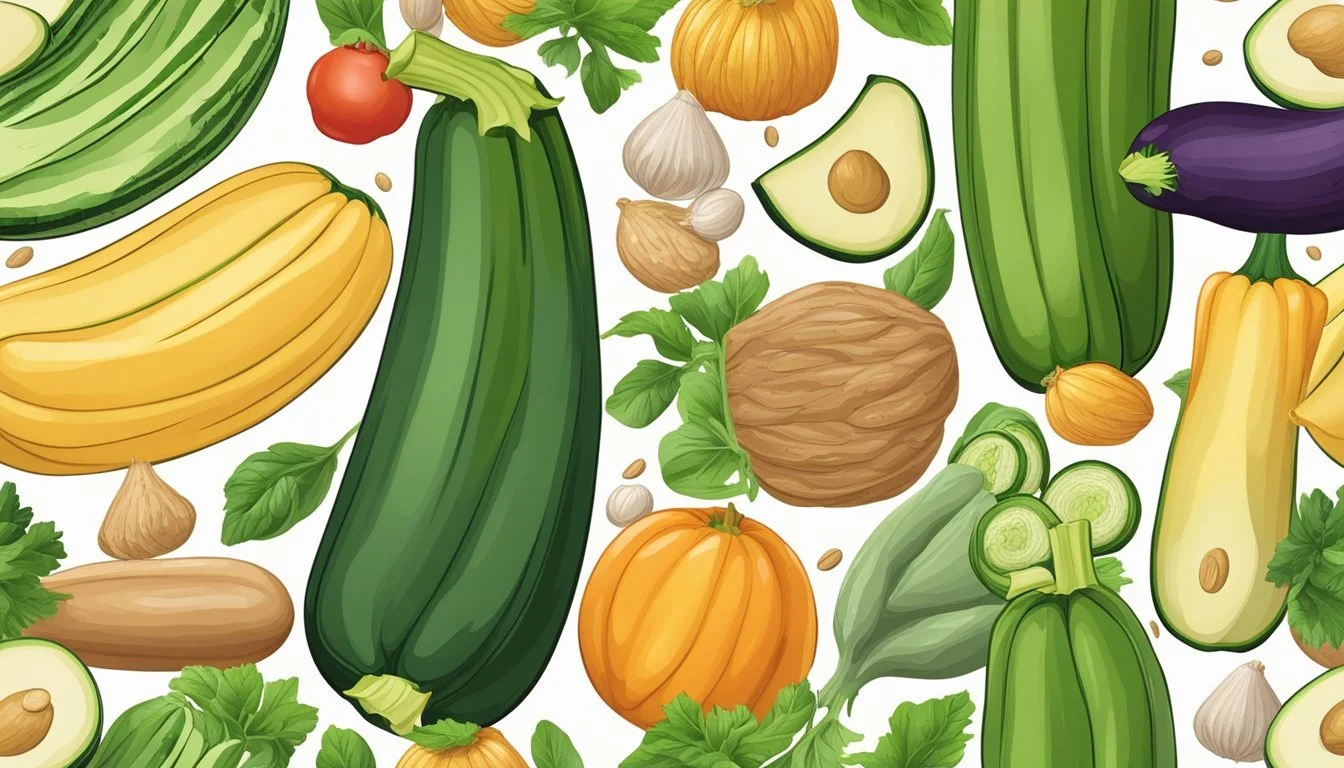Can Diabetics Eat Zucchini?
Exploring the Benefits for Blood Sugar Control
Zucchini (What wine goes well with zucchini?), a type of summer squash, has emerged as a favored option for individuals managing type 2 diabetes. This low-calorie, low-carbohydrate vegetable is known for its versatility in the kitchen and its useful nutritional profile. For those with diabetes, managing blood sugar levels is critical, and diet plays a pivotal role in this process. Zucchini stands out as a food choice that can be included regularly without major concerns of spiking glucose levels. Its high water and fiber content contribute to a feeling of fullness, which can help prevent overeating and assist with weight management, an important aspect for diabetes care.
Nutritionists often recommend the inclusion of vegetables like zucchini as part of a diabetes-friendly diet to not only help control blood sugar levels but also to provide essential nutrients without excessive calories. The versatility of zucchini allows it to be enjoyed in various forms—whether raw, steamed, roasted, or spiralized into noodles, providing a satisfying and nutritious alternative to higher-carb foods. Loaded with vitamins and minerals, and with its potential to be seamlessly integrated into smoothies, soups, casseroles, and even chili, zucchini offers a range of culinary opportunities for those looking to maintain a balanced diet while managing their diabetes.
Nutritional Profile of Zucchini
Zucchini is a nutrient-dense vegetable that offers a host of vitamins, minerals, and antioxidants, which contribute to its health benefits. This profile outlines the specific nutrients zucchini provides, showcasing its value in a balanced diet.
Vitamin and Mineral Content
Zucchini is an excellent source of vitamin C, an essential vitamin that supports immune health, skin integrity, and wound healing. It also contains significant amounts of potassium and magnesium, key minerals for maintaining heart health and muscle function. Additionally, zucchini offers a good variety of B-vitamins including vitamin B6, riboflavin, and folate which play vital roles in energy metabolism and the formation of red blood cells.
Caloric Value and Macronutrients
With only 17 calories per 100 grams, zucchini is a low-calorie food, making it an excellent choice for weight management. Its macronutrient profile exhibits a low carbohydrate content with roughly 3.1 grams per 100 grams, of which dietary fiber is 1 gram. Fiber aids in digestion and helps regulate blood sugar levels. Zucchini also provides a modest amount of protein, approximately 1.2 grams per 100 grams, which is important for muscle repair and overall health.
Antioxidants and Phytochemicals
The vegetable contains antioxidants such as carotenoids, including lutein and zeaxanthin, which are beneficial for eye health and may reduce the risk of age-related eye diseases. These antioxidants also contribute to the overall reduction of oxidative stress in the body. Moreover, zucchini's phytochemicals have been recognized for their potential anti-inflammatory properties.
Zucchini in a Diabetic Diet
Incorporating zucchini into a diabetic diet can provide multiple health benefits including blood sugar regulation, dietary fiber advantages, and aid in weight management.
Blood Sugar Regulation
Zucchini is a non-starchy vegetable, which means it has a low glycemic index and is less likely to cause rapid spikes in blood sugar levels. For individuals managing type 2 diabetes, consuming zucchini can help maintain steadier blood glucose levels. The presence of certain components in summer squash, which includes zucchini, has indicated lipid-lowering effects in animal studies that could also be beneficial for blood sugar management in humans.
High-Fiber Benefits for Diabetes
The high-fiber content in zucchini is essential for diabetic diets. Fiber aids in slowing down the digestion process, resulting in a more gradual release of glucose into the bloodstream. This helps control blood sugar levels and can improve insulin resistance. Additionally, a high-fiber diet is linked to improved heart health and blood pressure regulation, making zucchini an excellent food choice for those with diabetes.
Weight Management and Satiation
For those aiming for weight loss or weight management, zucchini can be a valuable addition to their diet. It is low in calories but high in fiber, leading to a feeling of fullness and satiation. This can reduce the overall calorie intake and combat obesity, which is often linked to the development of type 2 diabetes. Including zucchini as part of meals can support healthy metabolism and aid in maintaining a balanced diet for diabetics.
Incorporating Zucchini into Meals
Zucchini is versatile in the kitchen, offering a nutritionally sound choice for anyone, including those with diabetes. This low-carb vegetable can be transformed into a variety of dishes, adapting to many flavors and cooking methods without spiking blood sugar levels.
Zucchini-Based Recipes and Alternatives
Zucchini's adaptability makes it excellent for creating alternatives to high-carb items like pasta and pizza crust. Spiralized zucchini can replace traditional noodles, often referred to as zoodles, to offer a lighter, diabetes-friendly pasta dish. Similarly, grated zucchini mixed with egg and cheese can form a nutritious pizza crust base.
Pasta: Spiralize for a quick, healthy alternative to noodles.
Bread: Incorporate grated zucchini into bread for added moisture and nutrition.
Pizza Crust: Combine grated zucchini with binding ingredients to create a low-carb crust.
Preparation Techniques
Proper preparation can maintain both the flavor and nutritional value of zucchini. Steaming or grilling it for a short duration ensures minimal nutrient loss compared to boiling. Baking and roasting are also excellent methods to concentrate the zucchini's natural flavor with a boost from spices and herbs.
Steaming: 3-4 minutes.
Grilling: Brush slices with olive oil, season, and grill for 5-7 minutes.
Baking: Slice or stuff zucchini, then bake until tender.
Roasting: Dice or slice and roast to caramelize the edges for a sweet, rich flavor.
Creative Zucchini Dishes
One can introduce variety to their diet with creative zucchini dishes that don't compromise health. Zucchini boats, hollowed and stuffed with a mix of proteins and vegetables, are a meal in themselves. Chopped zucchini adds crunch to a salad, or it can be pureed into a soothing soup. Even incorporating zucchini into a vegetable juice blend can be refreshing and nutritious.
Zucchini Boats: Fill with cheese, meat, or veggies and bake.
Soup: Puree into soups for a silky texture.
Salad: Add raw for an extra crunch or grill for a smoky addition.
Vegetable Juice: Mix with other vegetables for a nutrient-packed drink.
By integrating zucchini in various forms—whether as a substitute for carb-heavy foods, baked into bread, or as a star in soups and salads—individuals can enjoy diverse and healthful meals.
Combining Zucchini with Other Foods
In managing diabetes, pairing zucchini with other appropriate foods can create balanced meals that regulate blood sugar levels. Zucchini, being a non-starchy vegetable, plays a vital role when combined with other diabetic-friendly foods.
Complementary Vegetables for Diabetics
Non-starchy vegetables like zucchini can be combined with a variety of other vegetables to enhance fiber intake without contributing significantly to blood sugar levels. Some of the best vegetables for diabetics include:
Leafy Greens: Spinach and kale offer abundant nutrients and minimal impact on blood sugar.
Cruciferous Vegetables: Broccoli, cauliflower, and asparagus are excellent choices for their high fiber content and antioxidants.
Additional Vegetables: Including tomatoes and carrots can add flavor and texture to dishes while still being diabetes-appropriate.
Proteins and Grains to Pair with Zucchini
Combining zucchini with proteins and whole grains can further help in stabilizing blood sugar levels. Suitable options include:
Proteins: Lean proteins such as chicken and eggs or plant-based options like beans serve as healthy accompaniments.
Grains: Quinoa is a high-protein, high-fiber grain that goes well with zucchini in meals.
Herbs and Spices for Enhanced Flavor
To avoid excessive salt, which can raise blood pressure, diabetics can use a variety of herbs and spices to flavor zucchini dishes. Noticeable tastes can be achieved through:
Pepper and Garlic: They add a robust flavor without affecting blood sugar levels.
Additional Seasonings: Fresh or dried herbs like basil or oregano contribute to a flavorful dish without adding unnecessary carbohydrates.
Health Benefits Beyond Diabetes
While zucchini is beneficial for individuals managing diabetes, its advantages extend to various other aspects of health, primarily due to its nutrient density and low-calorie profile.
Cardiovascular Health Improvement
Zucchini is a heart-healthy choice; it is low in cholesterol and high in fiber. Dietary fiber can contribute to lower cholesterol levels, which is critical in reducing the risk of heart disease. This vegetable also contains significant amounts of potassium, a mineral essential for maintaining healthy blood pressure levels.
Potassium Content: Helps in dilating blood vessels, reducing blood pressure.
Fiber: Aids in reducing blood cholesterol, protecting against atherosclerosis.
Anti-inflammatory Properties
The anti-inflammatory properties of zucchini come from its vitamin C, beta-carotene, and the presence of other antioxidants. Chronic inflammation can lead to various health issues, but regular consumption of zucchini can help mitigate this risk.
Vitamin C: Acts as an anti-inflammatory agent, supporting immune health.
Antioxidants: Help neutralize free radicals, reducing inflammation.
Reducing Cancer Risks
Zucchini is loaded with beneficial antioxidants and anti-inflammatory compounds, which may help lower the odds of developing certain types of cancer. These substances can combat the oxidative stress and inflammation that contribute to cancer development.
High Fiber Content: May reduce the risk of colon cancer.
Antioxidants: Such as lutein and zeaxanthin, have been linked with lower rates of cancer.
Dietitian Recommendations and Cautions
Dietitians recommend zucchini as a nutritious vegetable for diabetics due to its low carbohydrate content, which has minimal impact on blood sugar levels. It is important, nevertheless, to consider portion sizes and the method of preparation to ensure it fits within a diabetic diet.
Portion Sizes and Frequency
Portion Sizes: A typical serving size for zucchini is about one cup, either raw or cooked. Diabetics are advised to integrate zucchini into their meals without overconsumption to maintain balanced blood sugar.
Frequency: Regular inclusion of zucchini in the diet is encouraged, as it is high in water and nutrients with negligible added sugars.
Possible Interactions with Medication
Diabetics should monitor their blood sugar levels when consuming zucchini, especially if they are on medications like insulin. Zucchini's low carbohydrate content generally does not interfere with glucose levels, but individual responses may vary.
Consistent consumption of low carbohydrate vegetables like zucchini may require adjustments in medication over time, under a healthcare professional's guidance.
Adapting Zucchini for Special Diets
For Sodium-Restricted Diets: Zucchini should be prepared without added salt. Herbs and spices can enhance flavor without raising sodium content.
For Low-Fiber Diets: Zucchini is a good choice as it is naturally low in fiber, but it is versatile enough to be peeled or seeded to further reduce its fiber content if needed.







